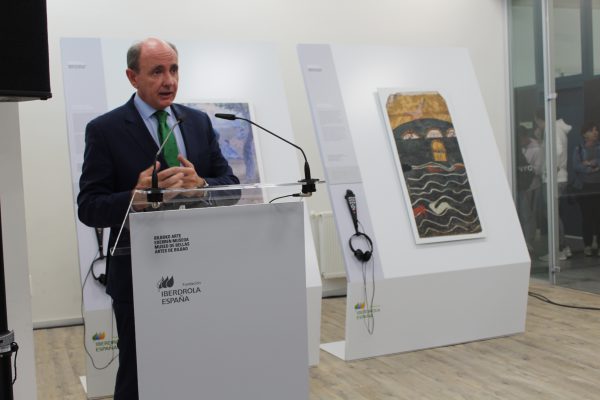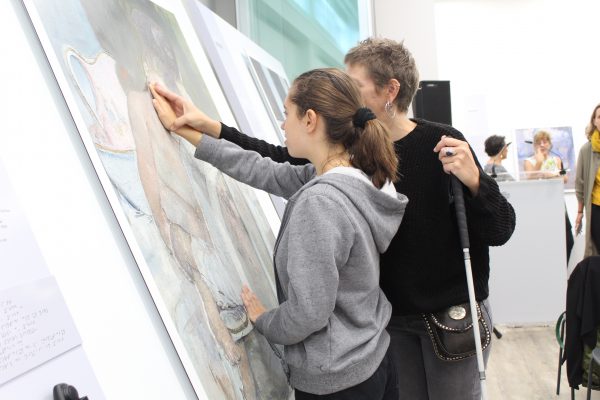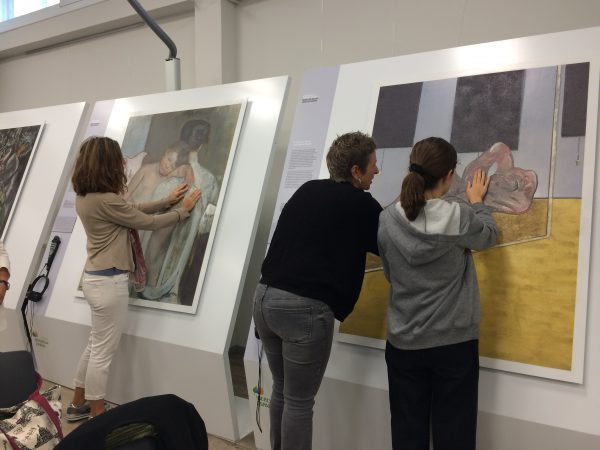With the participation of: Ramón Castresana, director of Fundación Iberdrola España; María Victoria Antoñanzas, head of the Bilbao Fine Arts Museum´s Education and Cultural Action Department; Mercedes Andrés, director of CRI Donostia IBT; Ander Soriano, director of Estudios Durero; and Miguel Zugaza, director of the Museum.
- Arte para Tocar, the pioneering visual accessibility programme that the Museum and Iberdrola began in 2012, will come to multiple schools in the Basque Country’s Gipuzkoa province in the 2019/2020 school year.
- Noah’s Ark, a Catalan Romanesque artwork dating from the 13th century, is the newest addition to the repertoire of tactile images in this educational programme.
IES Zubiri-Manteo BHI, San Sebastián, 02/10/2019— Since 2008, Iberdrola and the Museum have shared the aim of extending accessibility to an increasing number of audiences, and raising awareness of accessibility, through projects that use art as an educational tool. Among the activities and workshops held by the museum’s Department of Education is the pioneering Arte para Tocar, a programme aimed at people with visual disabilities. Begun in September 2012, it has since been adopted by museums like the Prado and the Thyssen in Madrid and the Pushkin in Moscow.
It is based on a technological development by Bilbao-based company Estudios Durero, which gives texture and relief to digital images of works in the museum’s collection, transforming them into media that can be explored through touch. The sensory experience is complemented didactically with an audio guide (in Basque, Spanish or English) to help visitors interpret the paintings. Also included are a commentary (in Basque or in Spanish) and a label in braille. Finally, to highlight the inclusive nature of the project, visitors are given masks so that anyone can experience the potential of the sense of touch.
The activity is led by educational staff who, using various support materials, facilitate discovery of the art works through touch and encourage dialogue.
New this year, in addition to the six original paintings selected for the programme, is Noah’s Ark, a Catalan Romanesque work dating from the 13th century. Schools in Gipuzkoa province interested in including this experience in their activities for the 2019/2020 school year will be able to use touch to discover seven masterpieces from the Bilbao Fine Arts Museum spanning diverse periods in the history of art: Catalan Romanesque (The Annunciation by El Greco and Saint Sebastian Tended by the Holy Women by José de Ribera), Italian baroque (Lot and his Daughters by Orazio Gentileschi), impressionism (Woman Sitting with a Child in Arms by Mary Cassatt, one of the movement’s most emblematic painters), and the second half of the 20th century (Lying Figure in Mirror by Francis Bacon), as well as one of the most representative of the Museum’s collection of works by Basque artists (Village Girl with Red Carnation by Adolfo Guiard).
After more than five years running the project in the museum, the exhibitor took the works to several schools in Biscay between 2018 and May 2019, bringing the programme to 4,459 students. The museum is now sharing this visual accessibility resource with schools in Gipuzkoa province thanks to the sponsorship of Iberdrola and the collaboration of the Gipuzkoa CRI (Resource Centre for the Educational Inclusion of Students with Visual Disabilities), part of the Basque Government’s Department of Education.
Any school can request a visit from this free, week-long exhibition, to take place between October 2019 and May 2020, with priority given to schools linked to the CRI.
IBERDROLA, committed to society
Since its beginnings, Iberdrola has been committed to the energy, cultural and social development of the communities in which it operates. The Fundación Iberdrola España represents one more step in this commitment; through the development of initiatives to help improve people’s quality of life. One of the areas it focuses its activity on is cultural development, especially when it comes to cultural and artistic wealth.
It is within this context that the collaboration with the Bilbao Fine Arts Museum is framed, which includes supporting the Conservation and Restoration programme, creating training and research grants in the field of art conservation and restoration, collaborating in teaching activities specifically designed to promote the museum’s collection to audiences with special needs due to visual or cognitive disabilities, and participating in social inclusion programmes.




